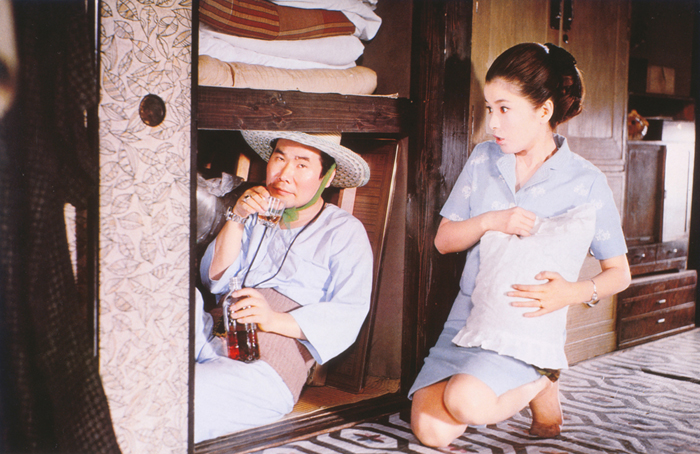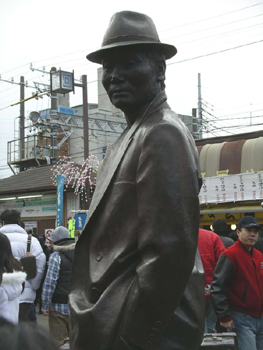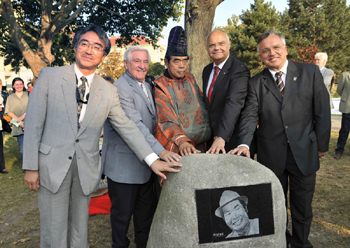 The antics of traveling salesman Tora-san (Kiyoshi Atsumi) often frustrated his family, including loving sister Sakura (Chieko Baisho). Scene from IT’S TOUGH BEING A MAN, the first Tora-san movie and one of four films in AnimEigo`s new DVD box set. Photo courtesy of AnimEigo, Inc. © 1969 Shochiku Co., Ltd.
The antics of traveling salesman Tora-san (Kiyoshi Atsumi) often frustrated his family, including loving sister Sakura (Chieko Baisho). Scene from IT’S TOUGH BEING A MAN, the first Tora-san movie and one of four films in AnimEigo`s new DVD box set. Photo courtesy of AnimEigo, Inc. © 1969 Shochiku Co., Ltd.An Interview with Stuart Galbraith IV Author: Keith Aiken Official Site: tora-san.jp (Japan)
On November 10, AnimEigo will release the TORA-SAN COLLECTOR’S SET: VOL. 1, a Region 1 DVD collection of the first four films in Shochiku`s beloved Tora-san series. With 48 movies produced from 1969 to 1995, Tora-san (Otoko wa Tsuraiyo, lit. “It’s Tough Being a Man”) is Japan`s longest running motion picture series and holds the Guinness Book World Record as the longest film series starring the same actor. The films starred Kiyoshi Atsumi as Torajiro Kuruma, a bumbling traveling salesman whose visits home would regularly bring chaos to the lives of his disapproving family. Award-winning director Yoji Yamada (THE INUGAMI FAMILY, THE TWILIGHT SAMURAI) co-wrote every Tora-san film and directed 46 of them. The pairing of Yamada and Atsumi was so consistently successful at the box office that Shochiku released a new Tora-san movie every summer and winter for two decades. A key contributor to AnimEigo`s TORA-SAN COLLECTOR’S SET is film historian Stuart Galbraith IV. Stuart is the author of several books, including Monsters Are Attacking Tokyo! (1998), The Emperor and the Wolf: The Lives and Films of Akira Kurosawa and Toshiro Mifune(2002), The Toho Studios Story: A History and Complete Filmography (2008), and Japanese Cinema (2009), and has provided DVD audio commentaries and liner note essays for such titles as Criterion`s three-disc SEVEN SAMURAI DVD, BCI Eclipse`s THE QUIET DUEL, and Classic Media`s Godzilla film INVASION OF ASTRO-MONSTER.
Stuart is also an old friend of SciFi Japan, and was happy to discuss the background and long-lasting appeal of Tora-san and also provide some insider details regarding the new DVD set... SciFi Japan: 48 films in 26 years is an amazing run. What was it about Tora-san that clicked so strongly with Japanese audiences for so long? Stuart Galbraith IV: It’s a number of different things. Kiyoshi Atsumi is simply wonderful — he’s really funny and the character of Tora-san, the itinerant and often lovesick street peddler, is sweetly naïve and childlike. Critics have compared him quite favorably to Charlie Chaplin and his Little Tramp character, but personally I think in terms of characterization he’s more like Oliver Hardy. “Tora-san” is a film series like the Godzilla or James Bond or Zatoichi. All 48 films were co-written by Yoji Yamada, who also directed all but two of them. Unlike Godzilla or the 007 series, the Tora-san movies were unique in that the same core filmmakers — the DP, the composer of the music, etc. — created each film, and the same ensemble cast appears in every, or most every film. Basically, these are comedy-dramas starring the great actor comedian Kiyoshi Atsumi. Tora-san is a tekiya, an itinerant street peddler, who travels up and down Japan, selling his wares are local festivals and the like. It’s a disreputable profession, something akin to being a carny, and he’s uneducated, unsophisticated, and generally irresponsible. The catch is that he also has a huge heart, and is kind and emotionally open to people in a way that’s very rare in Japan; he’s direct in a society archly indirect about almost everything.
In almost every film Tora-san falls in love with some beautiful woman, usually someone way beyond his social standing, and oftentimes she’s attracted to him — sometimes platonically, sometimes she genuinely falls in love with him. In each film Tora-san also visits his family in Tokyo. The family has a real love-hate relationship with Tora-san; inevitably they get into huge quarrels, and that gives way to a lot of really funny comedy. For Japanese audiences, through Tora-san they could vicariously do what they cannot. Tora-san could wander all over Japan at his leisure, meeting strangers on the road, drinking with them all night, telling jokes, and never have to worry about going to work the next morning. And because he was under-educated and lacked sophistication, he was naturally direct in a society often archly circumspect. Ultimately though, the films are just wonderfully funny and warm-hearted. For western world fans, I think a big part of the appeal is that films are like a time capsule of daily family life in Japan, from the late-1960s through the mid-1990s. Tora-san’s family ages in real time, so to speak. They get older and their fortunes rise and fall with the Japanese economy. They get swept up in trends like the rising popularity of video games or are affected by the oil shock, the Kobe earthquake, and so forth. If [Yasujiro] Ozu’s films express domestic life and concerns among Japanese families in the 1930s through the early-‘60s, then the Tora-sans fill that need for the quarter-century or so after that. If you’re interested in everyday Japan, the Tora-san movies are a great introduction. SciFi Japan: Was Shochiku known for making these kinds of family comedy-dramas? Stuart Galbraith IV: Not really, at least nothing quite like this. They had specialized in women’s dramas but really did all kinds of films. Shochiku had a somewhat more urban, sophisticated audience akin to Toho rather than, say, Daiei, Toei, or Nikkatsu in the sense that they did more comedies, and more contemporary dramas than jidai-geki or chanbara.
SciFi Japan: Was the first movie IT’S TOUGH BEING A MAN an original concept or was it based on an existing property such as a manga or anime? Stuart Galbraith IV: Actually, it was based on a popular television series also called OTOKO WA TSURAIYO. In the last episode of the series Tora-san, also played by Kiyoshi Atsumi, travels to Amami Oshima where he thinks he can make money catching poisonous snakes — there’s still a bounty even today for them, around ¥5,000 each, I think. Anyway, he gets bitten and his character dies. Viewers were so upset by this they flooded the network with angry phone calls, and some viewers even came down to the station to protest. Yoji Yamada genuinely felt terrible about this, and wanted to make the movie partly to bring Tora-san “back to life,” as it were. SciFi Japan: Who created Tora-san? Stuart Galbraith IV: Well, the Tora-san character really sprang from a number of different sources. Partly he was the creation of Yoji Yamada and writer-director Shunichi Kobayashi, but they patterned Tora-san after early postwar tekiya — the kind of slightly shady itinerant peddlers that actor Atsumi got to know very well in the years following World War II. Atsumi himself became involved with the black-market during this time and was eventually disowned by his father, and so there’s a lot of his personality in the character, too. SciFi Japan: Were any members of the main cast well known before the Tora-san movies? Stuart Galbraith IV: Kiyoshi Atsumi was already a very famous television comedian along the lines of Frankie Sakai [star of MOTHRA] and Hitoshi Ueki [of the Crazy Cats], and in the years before Tora-san was starring in movies like Susumu Hani’s BWANA TOSHI, a film I really wish some enterprising video label would release. Chieko Baisho was a pretty big star at Shochiku, on the level of somebody like Yuriko Hoshi or Reiko Dan at Toho. SciFi Japan: GODZILLA and SEVEN SAMURAI star Takashi Shimura had a semi-recurring role in three or four of the Tora-san films. What other popular/critically acclaimed actors guest starred in the series?
Stuart Galbraith IV: Too many to list! Virtually every major Japanese star of the Showa era eventually made a guest appearance in the series. In fact, the Tora-sans are like a Who’s Who of great Japanese actors and actresses. Toshiro Mifune. Kinuyo Tanaka, Hisaya Morishige, Machiko Kyo. Kyoko Kagawa, the wonderful actress who appeared in movies like TOKYO STORY, THE BAD SLEEP WELL, and MOTHRA, appears in TORA-SAN`S DREAM OF SPRING [Otoko wa Tsuraiyo, Torajiro Haru no Yume, 1979], which also features American character actor Herb Edelman who, incidentally, played a character named Michael Jordan. For monster fans out there, even Girara, The X from Outer Space himself, appears in one of the movies. SciFi Japan: Since this is SciFi Japan, I have to ask... what was Guilala doing in a Tora-san movie? Stuart Galbraith IV: All the later Tora-san movies have pre-title dream sequences. They were a chance for the cast to spoof other movie genres — yakuza films, chanbara, musicals, and even things like American private eye pictures. TORA-SAN`S FORBIDDEN LOVE [Otoko wa Tsuraiyo - Torajiro Shinjitsu Ichiro, 1984] was released just 13 days after the premiere of Toho`s much-publicized return to the kaiju eiga genre, the comparatively big budget GODZILLA (Gojira, a.k.a. GODZILLA: 1985). The Tora-san film opens with the sudden appearance of a giant monster, played via stock footage by Girara from THE X FROM OUTER SPACE [Uchu Daikaiju Girara, 1967]. "It`s Godzilla!" cries the Japanese Prime Minster (played by series regular Hisao Dazai), but scientist Hiroshi (Gin Maeda, who played Tora-san`s brother-in-law) corrects him: "No, it`s more like a pointy-headed lizard." The prime minister calls on eminent scientist and philosopher Tora-san to end the monster`s rampage, but he mourns the "cute" monster`s fate. SciFi Japan: What is a “Madonna” in the world of Tora-san? Stuart Galbraith IV: “Madonna” refers to the women Tora-san is always falling in love with, often but not always women way above his social standing. SciFi Japan: The series started at a time that the Japanese film industry was falling into decline. How did that impact Tora-san, and vice versa? Stuart Galbraith IV: It’s probably not an exaggeration to say that the Tora-san series single-handedly rescued Shochiku’s motion picture division from bankruptcy. SciFi Japan: Why did Tora-San come to an end in 1995?
 Tora-san`s hometown of Shibamata honored the character with a statue in front of Shibamata Station. © Shochiku Co., Ltd.
Tora-san`s hometown of Shibamata honored the character with a statue in front of Shibamata Station. © Shochiku Co., Ltd.Stuart Galbraith IV: It ended only because the star of the series, Kiyoshi Atsumi, died. He had been ill for a number of years, but when he made the 48th and final one, he was obviously a very sick man. That last entry [TORA-SAN TO THE RESCUE, Otoko wa Tsuraiyo - Torajiro Kurenai no Hana] is quite a touching film in the way it comes full circle in many ways, but watching Mr. Atsumi in that one isn’t easy — he was a dying man and looks it. SciFi Japan: The last movie was made almost 15 years ago. Has Tora-san maintained its popularity in Japan, or has it faded over time? Stuart Galbraith IV: From what I can tell, teenagers here in Japan are a bit less familiar with the series, but Tora-san has never gone away. It’s probably fair to say 99.5% of Japanese video rental stores carry the entire series on DVD. It was recently re-run on NHK’s BS network, and not long ago I caught a special on another HD channel about Tora-san’s old Tokyo neighborhood, Shibamata — where’s there’s currently a Tora-san museum. If Studio Ghibli is the Japanese Disney and Ultraman the Japanese Superman, Tora-san is, well… I don’t know. He’s as enduring and iconic as James Bond while as much a heartwarming annual tradition as MIRACLE ON 34TH STREET, IT’S A WONDERFUL LIFE, and HOW THE GRINCH STOLE CHRISTMAS all rolled up into one. SciFi Japan: Has the series been successful outside of Japan? Stuart Galbraith IV: Apparently it was quite popular in Austria, of all places, which is why Mr. Yamada made TORA-SAN GOES TO VIENNA [Otoko wa Tsuraiyo - Torajiro Kokoro no Tabiji, 1989]. The series seems to have caught on in China, especially in Hong Kong where they`ve been released on DVD. But generally, not so much. It’s a strange, maybe unique phenomenon. Very nearly every westerner I’ve ever met that’s seen one Tora-san movie eagerly wants to see more, but until recently seeing them with English subtitles has been extremely difficult. SciFi Japan: Have any of the Tora-San films been released in the United States before now?
Stuart Galbraith IV: Most were shown in a handful of Japanese neighborhood theaters until those places closed up in the late-1970s and early-‘80s. After that, you had to catch them at film festivals and other special screenings. For instance I saw one of the last ones, TORA-SAN, MY UNCLE [Otoko wa Tsuraiyo - Boku no Ojisan, 1989], at a Japanese film festival in Santa Monica in the early-1990s. I think it was shown one time and that may very well have been its only American screening. SciFi Japan: Why do you feel these films will be of interest to Japanese cinema fans in the west? Stuart Galbraith IV: Two reasons. Human comedy is basically universal, and where in the details it isn’t, the cultural differences can be fascinating in and of themselves. The other reason is that the films offers a unique, real-time portrait of an ordinary family and their daily life in Japan over the course of 48 movies. For fans of the series watching them grow and age over 25 years they become almost like family, the way characters on long-running American TV shows often do. As I said, once you’ve seen one, chances are you’ll be hooked for the rest of the series. Both Japanese and foreign audiences tend to respond to these films in a deeply personal way, the way cult movies and TV shows with an intensely loyal followings sometimes do. SciFi Japan: What is your role in the new Tora-San DVD set from AnimEigo? Stuart Galbraith IV: Well, I approached them because I think this is such a wonderful film series I wanted to do whatever I could to help it be a success for them, which in turn will help ensure they’ll eventually be able to release the entire series — all 48 films.
I did an audio commentary on the first movie. I was able to dig up a lot of good information that I think will help first-time viewers understand the series a little bit better, while offering those already familiar with the series some interesting nuggets of information. I was also able to contact Mr. Yamada, Chieko Baisho, Gin Maeda (who plays her husband, Hiroshi), Shinichi Kobayashi, and Sachiko Mitsumoto, the “Madonna” of the first film, and invited them to pass along any special messages to American viewers they’d like to offer. Some of their comments are really delightful. Besides the commentary track, I invited several esteemed Japanese cinema scholars to contribute essays for the booklet, namely Donald Richie, Michael Jeck, and Alexander Jacoby, along with Los Angeles Times film critic Kevin Thomas, who was a big fan of Tora-san when most of the series played the Kokusai Theater back in the 1970s. They were all quite enthusiastic about this release, too, and their comments are very insightful and add to the must-see nature of this release. SciFi Japan: Will AnimEigo’s DVD set use the same masters as other foreign releases like the Hong Kong DVDs? Stuart Galbraith IV: Absolutely not! These are new HD masters, all 16:9 enhanced. Last year Shochiku reissued the entire series to DVD with new masters and, for the first time, with English subtitles, but those discs are pretty expensive to import to America. Those DVDs had very good English subtitles, but AnimEigo has gone the extra mile improving the translations even more, offering optional annotations and to help viewers understand some of the humor. For the booklet I worked on, AnimEigo did something really smart: it includes a kind of guide to some of the more arcane humor, though I’d argue most of the humor in the Tora-san movies is universal and really easy to understand.
For more information on Tora-san please see the earlier coverage here on SciFi Japan:








